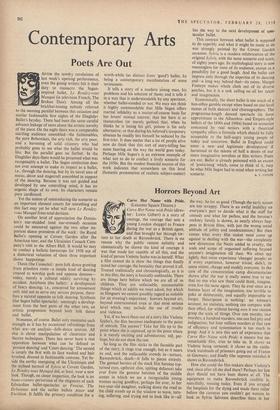Contemporary Arts
Poets Are Out
AFTER the tawdry revelations of last week's opening performance, even the gossip writers felt it their duty to massacre the Sagan- inspired ballet, Le Rendez-vous Manqué (in television French, The Broken Date). Among all the di! I brickbat-tossing nobody referred to the seeming parallel between this occasion and similar fashionable first nights of the Diaghilev Ballet's heyday. There had been the same careful advance leakage of news about the artistic novelty of the piece. On the night there was a comparable startling audience assembled—the fashionables, the pure Bohemians, the arty rich, the arty poor, and a leavening of solid citizenry who had probably gone to see what the ballet would be like. But the parallel goes no farther. In the Diaghilev days there would be presented what was recognisably a ballet. The Sagan confection does not ever attempt to make its impact as a ballet, i.e., through the dancing, but by its novel uses of music, ddcor and stagecraft assembled in support of the dancing. Because it was not guided and developed by one controlling mind, it has no organic shape of its own. Its characters remain pure cardboard.
Yet the notion of reintroducing the scenarist as an important element counts for something and this fact may yet be what will save Le Rendez- vous Manqué from total derision.
On another level of appreciation the Domin- ion's star-studded (and star-crossed) occasion could be measured against the two other im- portant dance premieres of the week : the Royal Ballet's opening at Covent Garden after the American tour, and the Ukrainian Cossack Com- pany's visit to the Albert Hall. It would be easy to confect a balletic horoscope for 1958 out of a dialectical valuation of these three important dance happenings.
Thesis (the Cossacks): pure folk dance groWing from primitive roots—a simple kind of dancing created to worship gods and appease demons— today, merely a cultural oddity surviving by accident. Antithesis (the ballet): a development of fancy dancing; i.e., conceived for amusement only and not to serve any serious purpose, there- fore a natural opposite to folk dancing. Synthesis (the Sagan ballet spectacle): seemingly a develop- ment from the best parts of the other two, an artistic progression beyond both folk dance and ballet.
Nonsense, of course. Ballet only maintains such strength as it has by occasional refreshings from what are—on analysis—folk-dance sources. All else is clever manipulation of classroom and theatre techniques. There has never been a real opposition between what can be defined as 'peasant dancing' and 'Court dancing.' The second is simply the first with its face washed and hair brushed, dressed in fashionable costume. Yet be- side the earthy energising of the Ukrainians and the stylised turmoil of Sylvia at Covent Garden, Le Rendez-vous Manqué did, at least, wear a new look. Though, on closer inspection, the look is an haute-couture perversion of the elegances of such Edwardian ballet-spectacles as Fentina, The
Debutante and the earlier ballets Amor and Excelsior. It fulfils the primary condition for a
worth-while (as distinct from 'good') ballet, by being a contemporary manifestation of some seriousness.
It tells a story of a modern young man, his problems and his solution of them; and it tells it in a way that is understandable by any spectator, whether ballet-minded or not. We may not think it highly commendable that Mlle Sagan offers marital infidelity as a matter-of-course basis for her lovers' mutual interest; that her hero is so resourceless (or merely gutless) that, when he thinks he is losing his girl, poison is his only alternative; or that during his beloved's temporary absence he readily lets himself be seduced by the first trier. It does matter that a lot of people alive now do think that this sort of story-telling has some bearing on the way the world goes today. Perhaps Mlle Sagan's is an extreme example of what not to do to confect a lively scenario for the 1950s. But the modest financial success of this work indicates that somewhere on this level (fantastic presentation of realistic subject-matter)
lies the way to the next development of spec- tacular ballet.
This contrast between what ballet is supposed to do superbly and what it might be made to do was strongly pointed by the Covent Garden occasion. Sylvia is a modern refabrication of the original Sylvia, with the same scenario and score, of eighty years ago. Its mythological story is now meaningless for most of its audience, except as a possibility for a good laugh. And the ballet can impress only through the expertise of its dancing and—a long way behind that—its mime. Margot Fonteyn makes whole cloth out of its diverse patches, but it is a task calling on all her talent and imagination.
Economically, the short ballet is too much of a box-office gamble except when based on star-level names of both dancers and choreographers. The programme-length danced spectacle (in form approximate to the Alhambra- and Empire-style ballets of the 1890s and 1900s) based on scenarios concocted by real writers with a theatrical sympathy offers a formula which should be fully acceptable to the half-angry young people of today and tomorrow. Ballet in England could enter a new and legitimate development if harnessed to the talents of half a dozen of our more imaginative novelists or film writers. Poets are out. Ballet is already poisoned with an excess of 'poeticising' which, come to think of it, may be what Mlle Sagan had in mind when writing her


































 Previous page
Previous page